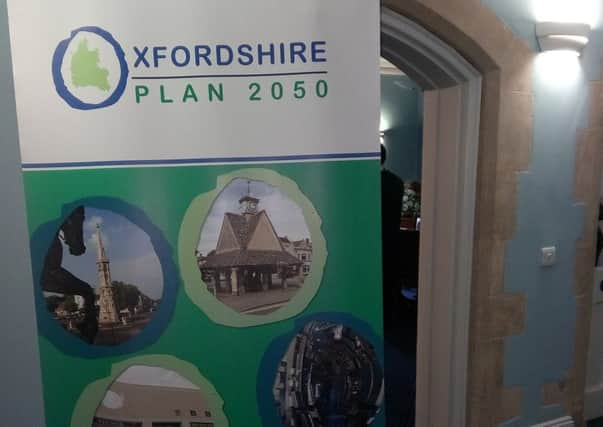Everything you need to know about the plan for how Oxfordshire will look in 2050


The scheme is the largest of its type in the UK and only the second one implemented and looks to turn housing, transport and connectivity planning on its head.
Rather than the number and type of future infrastructure developments being dictated by central government with a broad and generalised stroke, the OP2050 will gather information from all six local authority areas and form a plan that will work for Oxfordshire.
Advertisement
Hide AdAdvertisement
Hide AdIt also seeks a holistic approach to future planning aiming to understand the knock on consequences of house building in one area with connectivity in another, for example.


In 2018 the Oxfordshire authorities signed the Oxfordshire Housing and Growth Deal with the government. In return for guaranteed funding for affordable housing, infrastructure and economic growth, the Oxfordshire authorities have committed to submit a local plan for each district, to plan for the delivery of 100,000 new homes to 2031 (through those local plans) and to produce the Oxfordshire Plan.
The growth deal commits to an Oxfordshire plan that covers the period to 2050. This is a significantly longer period than is typical with a local plan and is important in this wider context.
A significant amount of joint work across the Oxfordshire authorities has already taken place which has fed into the current and emerging round of local plans.
Advertisement
Hide AdAdvertisement
Hide AdThese local plans cover the period from 2011 to 2031, 2034 or 2036.
There is therefore a good deal of detail and certainty around that period as plans are well advanced.
The latter period of the Oxfordshire Plan to 2050 will be based on a new evidence base produced specifically for the project.
This first stage, introducing the Oxfordshire Plan 2050, began on February 11 and will run for a six week period until March 25.
Advertisement
Hide AdAdvertisement
Hide AdInterest in the plan was high, according to Peter Truman, communication advisor with OP2050. He said: “We had a big flurry of people from about 3pm.
“People were waiting for us so there were a lot of Banbury people keen to give us their point of view and opinions and discuss what we’re doing.
“This is very much the start of the conversation setting out the context, aspirations and spatial scenarios. It’s very much the ideas stage, a spatial plan for the whole county.”
Oxfordshire Plan overview
The Oxfordshire Plan 2050 will be submitted to the planning inspectorate for independent examination by March 31, 2020 and adopted by March 31, 2021, subject to the examination process.
Advertisement
Hide AdAdvertisement
Hide AdThe plan will look at a number of key areas important to Oxfordshire. They are: housing, economic growth, strong and healthy communities, securing nature’s benefits, heritage, improving connectivity and movement and energy.
It is a joint venture involving all four district councils and Oxford City Council who will all act in an advisory capacity.
Stage one, the ideas phase will run until March 25.
Stage two will be the options stage devised by collating the public’s input during stage one and will also be open to a public consultation later in the year.
Predicting how we’ll work in future
One of the aims of the consultation is to look at current trends within employment, transportation and housing and determine which ones are likely to become more mainstream in the future.
Advertisement
Hide AdAdvertisement
Hide AdPeter Truman, communication and engagement advisor for Oxfordshire Plan 2050, said: “Because we are looking to 2050 we have to bear in mind how things might change.
“One of the things about connectivity is it isn’t just physical connectivity as in transport it is also digital connectivity. If everyone gets high speed broadband, and more and more people are choosing to work from home on flexible hours etc, then will the old model of nine to five still be how we work in 2050?”
He added: “So if you make sure when you build houses they have the capacity for digital connectivity, then just because you have more homes it doesn’t mean there are more cars on the road.
“If you look at the jobs and working patterns from 30 years ago and think about that 30 years into the future, a lot of jobs might not even exist and there will be a lot of jobs that we never thought possible in 30 years time and some of that might not be nine to five.”
Advertisement
Hide AdAdvertisement
Hide AdTransportation is another area where the future has already arrived and is developing at pace.
Electric cars, emission free zones, the banning of diesel cars and car sharing are just some of the factors that will have significant impact on the county in three decades time.
Mr Truman said: “We need to think about trains, buses and public transport. I was in Lisbon recently and they have electric scooters now that people can use to get from A to B, like Boris Bikes but electric.
“It’s inevitable that if schemes like that work they will expand and maybe, in the future, you cycle to a transport hub and get some form of transport from there.”
Advertisement
Hide AdAdvertisement
Hide AdHe added: “There is a commitment to promoting cycling and walking in the plan. It’s more than just houses and roads and that’s the key message.”
What’s next for the Oxfordshire plan?
Stage one of the consultation has almost reached its conclusion but there will be opportunities for public input as the plan develops.
Peter Truman, communication and engagement advisor, said: “This ends on March 25, then we will go through all the comments and produce a consultation report on what people said.
“Then we will use that information for the next consultation which will look at areas. This one is all about aspirations or the issues section. You then have options and the options consultation will say ‘OK, this is what you have said is important to you and you agree with us that we want to achieve these things and this is where we are potentially looking at putting developments and infrastructure to achieve that.’
Advertisement
Hide AdAdvertisement
Hide Ad“We’ll then have a consultation on that later in the year. Then when that has come in we will use the information to produce the final plan.
“The final draft plan will go to consultation public and then goes in front of every district council and Oxford City Council.”
He added: “One of the accusations that sometimes comes back is this is all done behind closed doors, but this plan is anything but. We have three public consultations and every single one goes before all the councils and it also goes to a scrutiny panel and an independent assessor.
“By the time we get to the end it would have been seen by a lot of eyes. We’re not hiding and we want people to tell us what they think.”
Advertisement
Hide AdAdvertisement
Hide AdTo comment on the plan visit www.oxfordshireplan.inconsult.uk, people leaving comments could win £50 shopping voucher.
Comments can be directly inputted onto any part of the document.
Alternatively you can email your comments to the Oxfordshire Plan Team at [email protected]